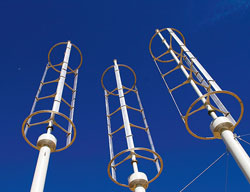sierraclub.org - sierra magazine - march/april 2013 - wind rush: look to the fishes
Biomimicry provides design for cheaper, smaller turbines

CalTech biophysicist (and MacArthur Foundation "genius grant" winner) John Dabiri applied what he learned studying the fluid dynamics of schooling fish to design an entirely new wind
turbine. | Ann Summa/Getty Images, courtesy of the John D. & Catherine T. MacArthur Foundation
 John Dabiri's turbine design. | John Dabiri/Caltech
John Dabiri's turbine design. | John Dabiri/Caltech
In the electricity-generating game, energy efficiency can be the difference between profit and poverty, competitiveness and collapse. The most finely tuned wind turbines convert 47 percent of the wind that strikes them into electric energy. They compare favorably to the average coal-fired power plant, which is only 32.5 percent efficient, according to the U.S. Department of Energy. New combined-cycle natural gas plants can go as high as 60 percent, but most U.S. gas generators use older technology that averages 44.8 percent. The typical car doesn't even hit 20 percent efficiency; internal combustion usually wastes 8 of every 10 dollars' worth of gasoline a car consumes. So that towering turbine cranking away in the rural hinterland is a paragon of efficiency.
But there's an important caveat to wind's efficiency numbers: They apply only to a single turbine. When it comes to wind farms, the whole is less than the sum of its parts because the turbines interfere with one another. The towers on the leading edge of incoming wind block those in back and create vortices that make the rest of the wind farm less efficient and its electricity more costly.
So far, the only effective solution has been to place individual turbines as far apart as possible, typically 7 rotor diameters. (The latest research suggests that a distance of 15 diameters works even better.) With rotors now regularly spanning or exceeding the size of a football field, wind farms can require hundreds or thousands of acres just to minimize turbine interference.
But what if that interference could be used as an advantage?
That's the question driving John Dabiri, director of the Center for Bioinspired Wind Energy at the California Institute of Technology in Pasadena. The answer, he says, can be found in the movements of fish, which he observed at length for the research on fluid dynamics and biomimicry that won him a MacArthur "genius grant."
"Schools of fish swimming in the ocean have to contend with vortices and disturbances caused by the other fish," he says. "Some species use less energy to move from point A to point B in groups than when they're by themselves, because they are able to use these vortices to enhance their swimming performance."
To Dabiri, those fin-driven vortices resemble the air currents that so bedevil wind farms. So he tried to design a wind farm that fed on that interference, the way schools of fish do. As commonsensical as this may sound, it makes Dabiri something of a wind heretic, because packing turbines together requires rejecting the familiar three-bladed fan atop a tall tower, the "horizontal axis" design that dominates world wind farming. Extensive computer modeling, wind-tunnel testing, and real-world experience have indeed confirmed this configuration's efficiency, which approaches the theoretical efficiency limit of 59.3 percent (a function of the fundamental laws of conservation of mass and energy).
Dabiri agrees that the traditional windmill design is the most efficient—but only if you have a wind farm with only one turbine. For a cluster of wind machines, he says, you need vertical-axis turbines.
A relic of the early years of wind energy development, vertical turbines don't even look like windmills. Their hubs are perpendicular to the ground, so their blades spin like carousels—or more aptly, like rooftop ventilators. They are smaller, simpler, and cheaper than traditional turbines, with the drawback that, one on one, they are only half as efficient. It's easy to see why: At any one time, half of the blade surfaces on a vertical turbine face the wind, while the other half point the wrong way.
That's where the fish come in. Dabiri's vertical turbines stand about 30 feet tall, one-tenth the height of many conventional turbines, and he can pack hundreds of the diminutive machines into the area normally reserved for one traditional turbine. In his CalTech lab and at an experimental desert wind farm in the Antelope Valley, north of Los Angeles, Dabiri positioned them to feed off the wind vortices of their neighbors, with the turbines close to each other spinning in opposite directions.
The results have been impressive. A modern commercial wind farm, with its large space requirements, generates about 2.5 watts per square meter, Dabiri says. One big conventional turbine typically generates from 1 to 3 megawatts of power. But even though his spinning carousels create only 3.5 kilowatts apiece, and it would take 280 of them to equal the capacity of a traditional 1-megawatt turbine, his vertical wind farms can generate 10 times as much energy in the same amount of space.
Dabiri believes he and his CalTech team can bring a 3.5-kilowatt vertical turbine to market for $3,500, which, watt for watt, would be as little as half the installed cost of a traditional turbine. And while conventional turbines involve giant cranes, construction crews, massive concrete foundations, and 8,000 parts, Dabiri's design has only two dozen parts and can be assembled with tools available at any hardware store.
Ideally, Dabiri would like to see hybrid wind farms that use the powerful giant models together with schools of small vertical windmills filling the spaces in between. "Wind energy is a mature technology that just needs to be made more efficient," he says. "We need a different approach—not just incremental change, but radically different ideas. Bio-inspired engineering can provide that." —E.H.
This article has been corrected.